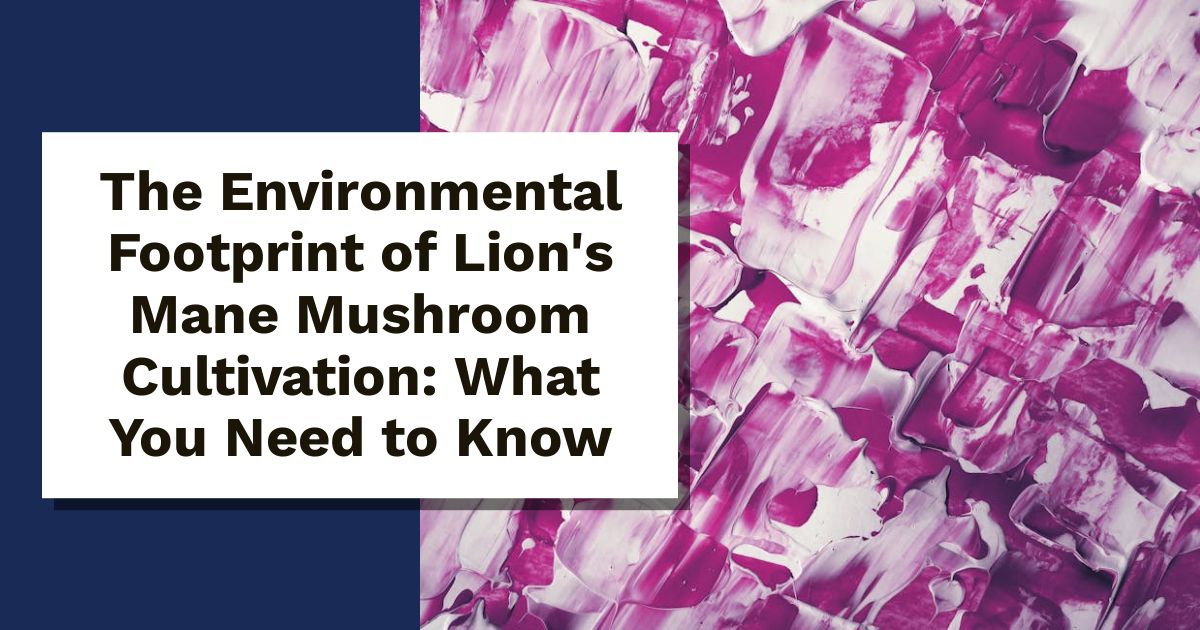Lion’s Mane mushrooms are taking the culinary and wellness world by storm. Known for their unique appearance and potential health benefits, they’re more than just a trendy ingredient. As demand grows, so does the need to consider their environmental impact.
You might be surprised to learn that mushroom cultivation can have varying effects on our planet. While these fungi offer an impressive nutritional profile, it’s essential to look at how they’re grown. From resource use to waste production, Lion’s Mane farming brings both opportunities and challenges.
In this post, we’ll explore the nitty-gritty of Lion’s Mane mushroom cultivation. We’ll break down how it affects the environment and what sustainable practices can make a difference. Whether you’re a mushroom enthusiast or just curious about this fascinating fungi, there’s plenty to discover.
What is Lion’s Mane Mushroom?
Lion’s Mane mushroom, or Hericium erinaceus, stands out not just for its health benefits but also for its striking looks. This unique fungus has a lot to offer, drawing attention for both culinary delights and wellness properties. Let’s break down what makes it truly special.
Appearance and Taste
Lion’s Mane mushrooms have an eye-catching appearance. With their fluffy, white, shaggy appears, they resemble a lion’s mane—hence the name. Growing in clusters, these fungi have long, hair-like spines that dangle down like soft icicles. They are typically the size of a large grapefruit or a fist, making them hard to miss.
When it comes to taste, Lion’s Mane mushrooms offer a flavor profile that doesn’t disappoint. Many describe it as having a subtle, sweet taste with a texture similar to seafood, especially crabmeat. This makes them a fantastic addition to various dishes, from stir-fries to soups. For cooking tips and flavor inspirations, check out this Delicious Life guide.
Health Benefits
Beyond their culinary appeal, Lion’s Mane mushrooms pack a punch when it comes to health benefits:
- Cognitive Function: Research suggests that Lion’s Mane can help protect brain health. Studies show it may improve memory and cognitive abilities, making it a popular choice for those looking to boost their mental sharpness.
- Nerve Health: These mushrooms are known to enhance nerve growth factor (NGF) production, which is crucial for the growth and maintenance of neurons. This can aid in recovery from nerve damage and support overall nerve health.
- Mood Support: Consuming Lion’s Mane might help reduce symptoms of anxiety and depression. It’s believed to have a calming effect, potentially improving overall mental well-being.
- Immune System Boost: Rich in antioxidants, Lion’s Mane mushrooms can help support your immune system, keeping you healthy.
For an in-depth look at the health benefits, take a look at this Healthline article.
Lion’s Mane mushrooms are not just a culinary delight; they also contribute significantly to health. Whether you’re interested in boosting your brainpower or simply enjoying a delicious meal, this mushroom deserves a spot on your plate.
Cultivation Methods
Understanding different cultivation methods for Lion’s Mane mushrooms is crucial for both novice and seasoned growers. Each method brings its own set of benefits and challenges that can affect not only the mushrooms produced but also their environmental impact.
Indoor vs. Outdoor Cultivation
When it comes to growing Lion’s Mane mushrooms, the first decision is whether to do it indoors or outdoors. Each method has its unique advantages and drawbacks:
Indoor Cultivation:
- Pros:
- Controlled Environment: Growers can manage temperature, humidity, and light, which helps produce consistent yields throughout the year.
- Fewer Pests: Indoor settings often mean fewer pests and diseases, reducing the need for chemical treatments.
- Year-Round Production: Ideal for those looking to produce Lion’s Mane mushrooms outside of seasonal constraints.
- Cons:
- Higher Energy Use: Running ventilation, heating, or cooling systems can consume significant energy.
- Setup Costs: Initial investment for equipment and setup can be expensive.
For more insights, check out this article on Growing Mushrooms Indoors vs. Outdoors.
Outdoor Cultivation:
- Pros:
- Natural Conditions: Utilizing natural elements can enhance the flavor and texture of mushrooms.
- Lower Energy Costs: Less energy is typically required compared to indoor systems.
- Cons:
- Unpredictable Yields: Factors like weather and pests can affect crop yields significantly.
- Labor-Intensive: Requires more physical work during log cutting, inoculation, and harvesting.
To find out more about the pros and cons of each method, visit this Cornell Small Farms article.
Substrate Choices
The choice of substrate is critical in growing Lion’s Mane mushrooms. It directly impacts nutrient supply, growth rate, and overall mushroom quality. Here are some common substrates and their effects:
- Hardwood Sawdust: This is one of the best substrates for Lion’s Mane. It mimics the natural habitat of these mushrooms and provides essential nutrients.
- Wheat Bran: Often used as a supplement, wheat bran boosts nitrogen levels, promoting healthier mycelial growth.
- Hardwood Chips: These can also serve as a substrate, but they may require additional supplements for optimal growth.
Choosing the right substrate can enhance the economic sustainability of cultivation. For detailed information, explore this guide on Growing Lion’s Mane Mushrooms.
Whether you’re growing indoors or outdoors, the method and substrate you choose can significantly affect both your yield and the environmental footprint of your mushroom cultivation. So, what will you choose for your Lion’s Mane adventure?
Environmental Impact of Cultivation
The environmental footprint of Lion’s Mane mushroom cultivation is multifaceted, reflecting its interplay with nature. Understanding key aspects like resource use, carbon emissions, and waste management helps reveal the full ecological picture.
Resource Use
Water and land are crucial in cultivating Lion’s Mane mushrooms. Unlike some crops, mushrooms generally require less water. However, maintaining moisture levels in growing substrates is essential for healthy yields. Here’s what you need to know:
- Water Needs: Lion’s Mane thrives in moist conditions. Typically, growers need to water once or twice a week to keep logs hydrated. If logs dry out, it can hinder growth. Effective water management ensures the mushrooms stay healthy without excessive waste. For more on watering techniques, check this Growing Lion’s Mane Mushrooms guide.
- Land Usage: Growing mushrooms takes up less space than traditional farming. Cultivators often utilize small plots or even indoor spaces, maximizing land use efficiency. This compact nature can lead to higher yields per square foot compared to various crops.
Consider the sustainability of your choices. Selecting local resources reduces transportation emissions and supports smaller ecological footprints.
Carbon Footprint
The carbon footprint associated with Lion’s Mane cultivation varies depending on the method used. Mushroom farming generally ranks low in greenhouse gas emissions, making it an environmentally friendly option. Here’s a deeper look:
- Indoor vs. Outdoor: Indoor farming can lead to higher energy use since it relies on artificial lighting and climate control. However, the total emissions often remain lower than those of many traditional crops. In contrast, outdoor cultivation is more energy-efficient but less predictable due to environmental factors.
- Yield Efficiency: Research indicates that producing just one pound of mushrooms generates only about 0.7 pounds of CO2 equivalents. This efficiency makes mushroom farming a low-impact alternative. To dive deeper into emissions from mushroom farming, visit the Mushroom Life Cycle Assessment.
Understanding the balance of energy inputs versus outputs can help growers and consumers make informed choices.
Waste Management
Mushroom cultivation naturally produces a considerable amount of waste. For every kilogram of mushrooms harvested, around three kilograms of byproducts are created. Here’s how to think about waste in this context:
- Byproduct Handling: The leftover materials, often rich in nutrients, can be repurposed as compost or animal feed. This practice minimizes waste and enhances soil quality, contributing to sustainable agriculture.
- Pollution Control: Efficient waste management can help mitigate pollution. Utilizing waste to grow mushrooms can serve as a method for managing agricultural byproducts and aiding in environmental cleanup. Check out this article on Mushroom Production and Waste Management for insights into effective practices.
Addressing waste is not only practical but also integral to promoting a healthier ecosystem. Embracing sustainable options can lead to a more balanced and responsible cultivation approach.
Sustainable Practices in Lion’s Mane Cultivation
Sustainable practices in Lion’s Mane mushroom cultivation are essential for minimizing environmental impacts while maximizing productivity. By focusing on organic methods and innovative solutions, growers can promote ecological balance and ensure healthy crops.
Organic Cultivation Techniques
Organic cultivation techniques are designed to reduce environmental harm while producing high-quality mushrooms. Here are some key practices:
- Natural Inputs: Organic growers avoid synthetic pesticides and fertilizers. Instead, they use natural compost and organic materials as fertilizer. This supports soil health without harming nearby ecosystems.
- Soil Health: Healthy soil is crucial. Organic techniques emphasize building rich, living soils. Practices like crop rotation and cover cropping maintain soil structure and fertility.
- Water Conservation: Efficient water use is a priority. Organic farms often utilize methods like drip irrigation. This minimizes waste and ensures mushrooms receive the moisture they need to thrive.
- Biodiversity: By implementing polyculture farming, cultivators can increase biodiversity. Growing various species alongside Lion’s Mane can help prevent disease and pest issues.
Want to learn more about organic mushroom production? Check out this guide on Organic Mushroom Production.
Innovative Farming Solutions
Innovation plays a key role in making mushroom cultivation more sustainable. Here are some exciting technologies and practices:
- Precision Agriculture: Technologies like remote sensing and GPS mapping help farmers monitor their crops in real time. This data-driven approach can optimize water usage and nutrient applications, leading to higher efficiency and reduced waste. Discover more about this in Top 6 Breakthroughs Shaping the Future of Mushroom Farming.
- Automated Systems: Automation in substrate preparation and harvesting can cut down labor costs and increase efficiency. Systems that handle these tasks can help farmers maintain consistent production levels. Check out Cultivating Tomorrow: Innovations in Mushroom Farming.
- Improved Growing Conditions: Controlled environments, such as GrowPods, allow for optimal conditions for mushroom growth. These systems can increase yields while using less water and space. For details, see Produce Now Launches Innovative Mushroom Farming Initiative.
By adopting these organic and innovative practices, Lion’s Mane mushroom cultivation can thrive while effectively reducing its environmental footprint. How do you think these methods can change the future of mushroom farming?
Conclusion and Reflection
As we reach the end of our exploration into the environmental footprint of Lion’s Mane mushroom cultivation, it’s essential to reflect on what we’ve uncovered. The journey through sustainable practices and their implications reveals both challenges and opportunities.
Acknowledging the Impact
Lion’s Mane mushrooms offer significant health benefits, but their cultivation comes with an environmental cost. It’s crucial to understand the trade-offs involved. Here are some key factors to consider:
- Resource Use: While Lion’s Mane mushrooms generally require less water than traditional crops, the management of substrates can still be water-intensive. Sustainable practices can help minimize waste and improve efficiency.
- Carbon Emissions: The cultivation method plays a vital role in determining the carbon footprint. Indoor farming may lead to higher energy use, while outdoor farming can be more resource-efficient. Understanding where your mushrooms come from is essential.
- Waste Management: Byproducts from mushroom cultivation can either be seen as waste or as valuable resources. With proper management, these byproducts can enhance soil health and reduce environmental impact.
Reflecting on Sustainable Practices
Sustainability in Lion’s Mane cultivation is not just a trend; it’s a responsibility. Adopting eco-friendly farming methods doesn’t just benefit the environment but also leads to better quality mushrooms. Consider these practices:
- Organic Techniques: Relying on natural compost and avoiding synthetic fertilizers can benefit both your health and the planet. Organic methods promote biodiversity and healthier soils.
- Innovative Solutions: Embracing technology can cut down on waste and energy use. From automated systems to precision agriculture, innovation has the potential to transform mushroom farming in a positive way.
Looking Ahead
What does the future hold for Lion’s Mane mushroom cultivation? With rising interest in sustainable agriculture, there is a growing movement toward environmentally-friendly practices. As consumers, we have the power to influence these changes by supporting responsible growers.
Understanding the impact of our food choices is more relevant than ever. As you continue your journey with Lion’s Mane mushrooms, consider how your decisions can contribute to a healthier planet. For further reading, check this ScienceDirect article on mercury accumulation in mushrooms to learn more about safe practices in the cultivation of edible mushrooms.
The cultivation of Lion’s Mane mushrooms offers a tasty way to enjoy nature while also considering the environment. Being mindful of our impact encourages us to cultivate a better future—one delicious mushroom at a time.
Dr. Cordy is a passionate advocate for the incredible benefits of Lion's Mane mushrooms, blending scientific insight with a deep enthusiasm for natural wellness. When he’s not exploring the latest research on functional fungi, you’ll find him chasing waves as an avid surfer, strategizing over chess matches, or embarking on outdoor adventures that fuel his curiosity and love for nature. A devoted dog dad and lifelong explorer, Dr. Cordy combines his diverse passions with a mission to educate and inspire others about the transformative potential of Lion’s Mane mushrooms. You can unearth his latest Lion's Mane insights here. 🍄


